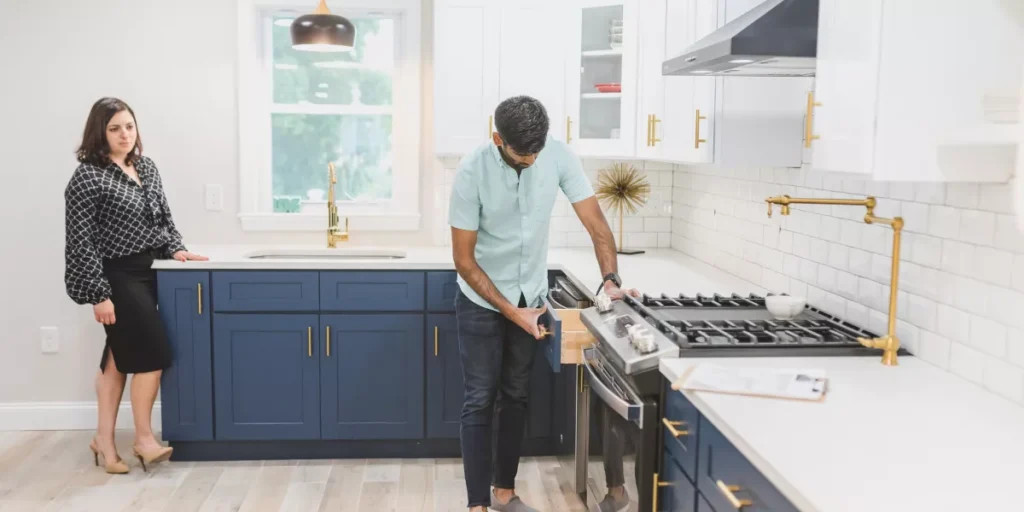Buying a home can be stressful, especially if as a homebuyer you’re not sure what to look for during a walkthrough before closing. The final walk-through is your final or last chance to ensure everything in the house meets your expectations.
This article will show you step-by-step how to check important areas and spot potential problems. Read on to make your final walk-through a success and what to look for during a walkthrough before closing!
Understanding the Final Walk-Through Process & the Final Walk-Through Checklist
The final walk-through lets you inspect the property before closing day. It usually happens a few days before or even on the day of closing. You and your real estate agent will check if everything is in order. You are also advised to have a final walk-through checklist ready ready.
Expect this step to take 15 minutes for small homes and over an hour for larger properties. This visit makes sure repairs are done, appliances work, and there are no new damages since your last visit.
Essential Areas to Check in the Final Walk-Through
If you want to make sure that every part of the home is up to standard, check both inside and outside areas for any issues.
Inspecting the Home’s Interior as a Buyer

Check each room closely. Look for any damages or changes since your last visit. Verify that all agreed-upon items, like light fixtures and window treatments, are still there per the purchase agreement.
Pay special attention to moist areas like bathrooms and kitchens for signs of mold or water damage.
Test appliances thoroughly. Make sure ovens, dishwashers, washing machines, and HVAC systems work properly. Check the hot water heater by running hot water in sinks and showers. Also, look at heating and cooling units, including ceiling fans and thermostats.
Test lights, outlets, doors and windows, as well as locks to make sure the home and all its utilties function as expected within the final contract terms.
Examining the Home’s Exterior
As a home buyer, inspect the exterior and landscaping closely. Ensure gates, pools, and irrigation systems function properly. Look for signs of pests like rodents or termites.
Check garages and sheds for any of the seller’s belongings. Confirm that these areas are clear before closing.
Comprehensive Final Walkthrough Checklist
A thorough checklist allows the buyers to ensure a smooth final walk-through. Pay attention to key items and areas in the house for potential problems.
Confirming Inspection Repairs
Confirm that all promised or agreed-upon repairs have been made. Use the home inspection summary and accepted offer letter to verify. Check each fix yourself. Do not rely only on the seller’s word.
Ask the seller for warranties or repair receipts. This provides proof that work or repairs have been completed properly. Ensure everything matches what was agreed upon in the contract.
Testing Appliances and Systems
Testing appliances and systems is crucial before closing a home sale. This ensures everything works correctly and meets your expectations.
- Check the stove and oven. Turn them on to ensure they heat up properly.
- Inspect the refrigerator and freezer. Make sure they are cold and functioning.
- Test all faucets. Confirm water flows well and check for leaks.
- Flush each toilet. Ensure they flush correctly without any issues.
- Run the dishwasher. Start a cycle to confirm it operates smoothly.
- Test the clothes washer and dryer. Run a quick load to see if they work right.
- Turn on heating, ventilation, and air conditioning (HVAC) systems. Ensure both heating and cooling functions operate as expected.
- Check the hot water tank. Verify it heats water efficiently without delays.
- Examine garbage disposals. Turn them on and listen for any strange noises or malfunctions.
Next, let’s explore how to assess windows, doors, and locks during the final walkthrough.
Assessing Windows, Doors, and Locks
Assessing windows, doors, and locks is a crucial part of the final walk-through. They help secure your home buying process and keep it energy-efficient.
- Verify all locks and windows function properly. Beore the home purchase is finalized, make sure every lock latches without problems and each window opens and closes smoothly.
- Inspect window screens for defects. Look for rips or holes in the screens that could allow bugs inside.
- Ensure doors open and close smoothly. Doors should not stick or drag on the floor.
- Check for any broken or damaged locks. All locks need to be intact and provide proper security.
It’s important to check these areas carefully. This will help avoid future issues once you move into your new home with Rocket Companies, Inc.
Reviewing Electricity and Plumbing Systems
Reviewing the overall condition of the property, especially electricity and plumbing systems is crucial during a final walk-through. It ensures that everything works and there are no hidden issues.
Test all electrical outlets.
- Use a cell phone charger or multimeter to check if outlets work.
Examine light fixtures.
- Verify that all lights turn on without flickering.
Check the doorbell.
- Press it and listen for the chime; make sure it rings properly.
Inspect garage door openers.
- Test the remote and wall button to see if they open and close the garage door smoothly.
Evaluate water pressure.
- Turn on faucets to check both hot and cold water pressure.
Assess temperature settings.
- Make sure hot water heats up quickly and consistently.
Look for leaks in plumbing networks.
- Scan under sinks, around toilets, and near water heaters for any signs of leaks or moisture.
Flush toilets.
- Ensure they flush correctly without any clogs or weak flow.
Run showers and bathtubs.
- Check showerheads for steady water streams; ensure tub drains properly without slow draining signs.
Review heating and air-conditioning systems.
- Turn them on; confirm they heat or cool rooms efficiently.
This list helps spot potential problems in power sources or water supply lines before closing a home deal.
Potential Problems to Identify
You might find some problems during the final walk-through. Look for issues that could affect your new home’s value or safety.
Identifying Mold and Water Issues

Check moist areas for signs of mold. Bathrooms and kitchens are common spots. Look under sink cabinets, around toilet bases, and bathtub drains. These places can easily hide mold.
Look for water stains on ceilings and walls. Water damage might show as brown or yellow marks. Make sure there is no standing water in the basement. Mold loves dark and wet spots like basements.
For peace of mind, you may want to hire a home inspector. They can spot mold and water issues that aren’t obvious at first glance.
Detecting Pests and Infestation Signs
Spotting mold and water issues can often lead you to find pests and signs of infestation. Look for rodent or termite droppings in attics, basements, and corners of rooms. Droppings indicate a pest problem that needs attention before closing.
Inspect wooden structures for damage or sawdust, which are signs of termites. Dead insects around windowsills or doors suggest an insect issue. These are crucial checks to ensure your new home is free from unwanted guests before finalizing the sale with Rocket Mortgage or any other lender like Bank of America.
Noting Recent Damages or Vandalism
Check for any new damages to walls, floors, and fixtures. Make sure there are no signs of vandalism or forced entry. Look for broken windows or doors that could indicate recent trouble. Note any differences from the initial inspection.
Contact an experienced realtor if you find issues during the final walkthrough. They, with the help of checklist can help communicate with the seller about needed repairs or adjustments in price. Ensure these problems are fixed before closing the mortgage loan with Rocket Mortgage, LLC.
Actions to Take When Problems Arise
If problems arise, address them quickly. You might need to contact the seller and discuss possible solutions.
Communicating Issues to the Seller
Document issues with photos and notes. This provides proof of the problems found during the walkthrough. Discuss these issues promptly with your real estate agent. Make sure all communication is in writing for record-keeping.
Buyers can request repairs from the seller or negotiate a price adjustment. Promptly share any concerns through email or a written document. If needed, consider opening an escrow account to cover repair costs until they are completed.
Next, learn how to handle negotiations effectively by reading about “Negotiating for Repairs or Price Adjustments.
Negotiating for Repairs or Price Adjustments

Buyers can push for repairs or price adjustments. Use the home inspection report to back your claims. Point out any issues found during the walk-through. Request credits for future repairs if needed.
Make sure all agreements are in writing. Update the purchase contract to reflect these terms. This step keeps both parties on the same page and ensures legal backing.
Considering a Delay in Closing
If major issues are found during the final walk-through, consider delaying the closing. Problems like mold or pests may require more time to fix. Communicate these issues during the final walk-through process to the seller right away.
Consult with your real estate broker and legal advisors before making decisions. Major problems can lead to deal cancellation or even legal action. If needed, you might negotiate for repairs or ask for a price adjustment before proceeding again.
Final Walk-Through FAQs
Attendees of the Walk-Through
Being prepared for the final walkthrough and conducting the final walk-through is very important, and that to with the right attendees. Usually, the buyer and their real estate agent attend the final walk-through. The agent helps spot any problems and checks if the home isn’t ready or actually is ready to move into. Sellers or their agents may also join if both parties agree.
Keeping in touch with your agent regarding the checklist before you close is crucial. This ensures all issues found during the walk-through are addressed on time. The process helps confirm all repairs are complete, and nothing significant has changed since your last visit.
Scheduling the Walk-Through
Plan the walk-through a few days before closing. This gives a reasonable amount of time to address any issues. Consult your real estate agent to find a convenient time.
Aim for the inspection close to the closing day or closing date. Scheduling it too early might miss last-minute problems. Make sure there’s enough time for repairs or price adjustments if needed.
Expected Duration and Procedures
A very common question is how long does a final walk-through take? Well, the answer to the question of how long final walkthroughs take is very simple: final walk-throughs can take as little as 15 minutes for small homes. Larger properties might need over an hour. Walk through each room and use a checklist, camera, and notepad to document everything.
Test all appliances and systems like heating, cooling, plumbing, and electricity. Make sure repairs listed in the real estate contracts are done. If issues arise during the walk-through, communicate with the seller or consider delaying closing until problems get fixed.
Adjustments to price or further negotiations may be necessary based on findings.
Final Walkthrough Checklist: Conclusion
Checking every detail before closing is key. Confirm repairs are done. Test appliances and systems yourself. Document any issues you find. Address them with the seller right away. Doing this ensures a smooth move-in experience for you!
FAQs
1. What should I inspect during a walkthrough before closing on a house?
Check for any damage or issues with the property. Ensure all agreed repairs are completed and that systems like plumbing, heating, and electricity work.
2. How does my credit score affect closing?
A good credit score can help you secure better loan options, lower interest rates, and favorable terms from lenders like Quicken Loans or Capital One.
3. Why is understanding loan-to-value ratio important?
The loan-to-value (LTV) ratio affects your mortgage premium and eligibility for certain types of loans such as HELOCs or variable-rate mortgages.
4. Can I use savings or equity to cover closing costs?
Yes, you can use funds from your savings account or tap into home equity through refinancing options to manage closing expenses.
5. What legal aspects should I consider before finalizing the deal?
Ensure all documents are legally binding and fact-checked by professionals to avoid future disputes over tenancy, debt obligations, or counter offers.







